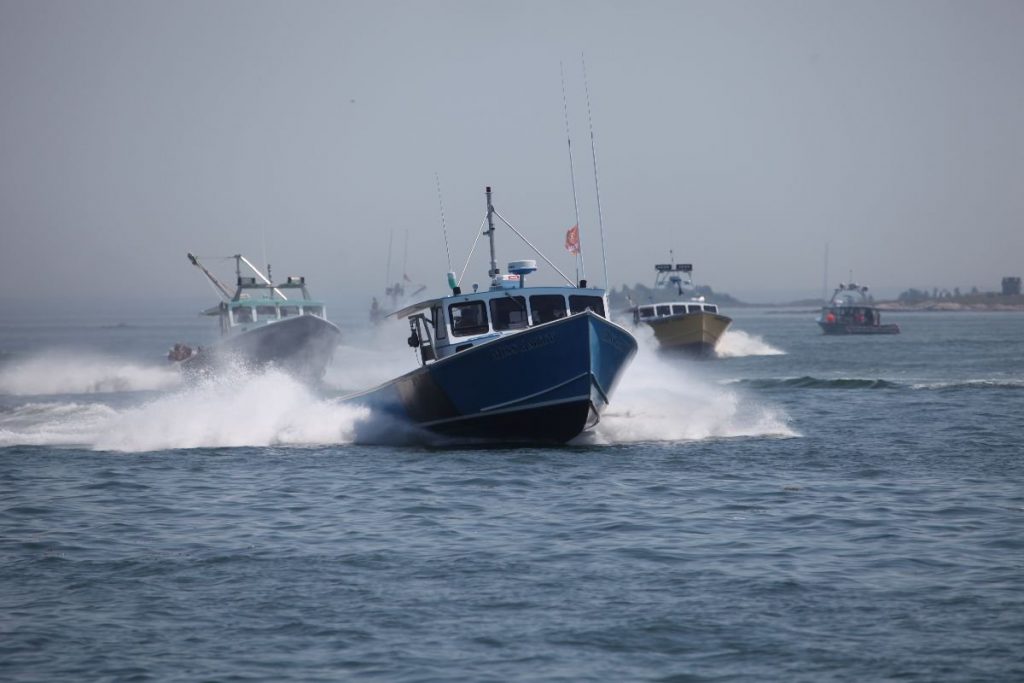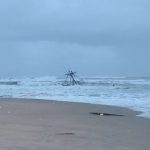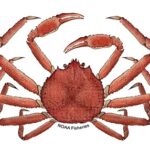Tag Archives: glass eel
Inside the Slimy, Smelly, Secretive World of Glass-Eel Fishing
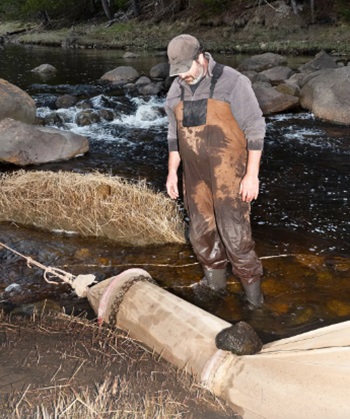 The Sargasso Sea, a warm, calm expanse of the North Atlantic Ocean, is bordered not by land but by four strong currents—a gyre. Vast mats of prickly brown seaweed float so thickly on the windless surface that Christopher Columbus worried about his ships getting stuck. The biodiverse sanctuary within and beneath the sargassum produces Anguilla rostrata, the American eel. Each female lays some eight million eggs. The eggs hatch as ribbonlike larvae that drift to the Gulf Stream, which carries them to the continental shelf. By the time they reach Maine, the larvae have transformed into swimmers about the length of an index finger, with the circumference of a bean sprout and the translucence of a jellyfish. Hence their nickname, glass eels, also known as elvers. The glass eel is barely visible, but for a dark stripe—its developing backbone—and a couple of chia seeds for eyes. “Ghosts on the water,” a Maine fisherman once called them. Travelling almost as one, like a swarm or a murmuration, glass eels enter tidal rivers and push upstream, pursuing the scent of freshwater until, ideally, they reach a pond and commence a long, tranquil life of bottom-feeding. more, >>CLICK TO READ<< 10:50
The Sargasso Sea, a warm, calm expanse of the North Atlantic Ocean, is bordered not by land but by four strong currents—a gyre. Vast mats of prickly brown seaweed float so thickly on the windless surface that Christopher Columbus worried about his ships getting stuck. The biodiverse sanctuary within and beneath the sargassum produces Anguilla rostrata, the American eel. Each female lays some eight million eggs. The eggs hatch as ribbonlike larvae that drift to the Gulf Stream, which carries them to the continental shelf. By the time they reach Maine, the larvae have transformed into swimmers about the length of an index finger, with the circumference of a bean sprout and the translucence of a jellyfish. Hence their nickname, glass eels, also known as elvers. The glass eel is barely visible, but for a dark stripe—its developing backbone—and a couple of chia seeds for eyes. “Ghosts on the water,” a Maine fisherman once called them. Travelling almost as one, like a swarm or a murmuration, glass eels enter tidal rivers and push upstream, pursuing the scent of freshwater until, ideally, they reach a pond and commence a long, tranquil life of bottom-feeding. more, >>CLICK TO READ<< 10:50
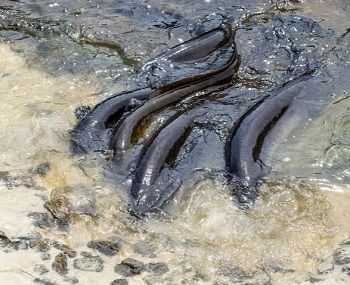
Eels – They may be Australia’s most hardcore animal
They may be no match for saltwater crocs or great white sharks, but for their size, our freshwater eels are surprisingly hardcore. These slippery fish can travel over land, take down serious prey, and climb walls, all without any freaking legs! Their shape-shifting rivals that of insects such as butterflies, moths and cicadas. And eels undertake one of the most epic migrations known within Australian waters, but to this day, their breeding grounds remain a mystery. Lurking in the muddy bottom of a river or dam is only part of an eel’s life. It’s like the Clark Kent bit. The rest is the stuff of fishy superheroes. photos, >click to read< with attached eel articles! 19:04
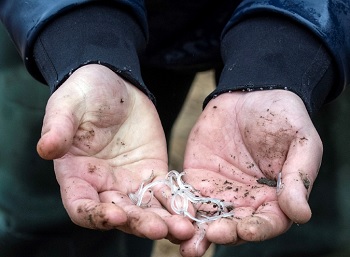
Coronavirus: Elver Season Starts, But Prices Plunge
At 8 a.m., Monday, March 30, about 30 elver fishermen were at the Pemaquid Falls town landing to claim their fishing spots for a shortened season. The elver, or glass eel, season in Maine got off to a late start because of a coronavirus-related delay from March 22 to March 30. Bristol Town Administrator Chris Hall said in a phone interview March 30 that he estimates there were at least 60 fishermen at Pemaquid Falls on opening day last year. The price of elvers has dropped significantly this year, from more than $2,000 per pound in 2019 to $500 per pound, the lowest starting price since 2010. This is down from a price of $2,700-$2,800 at the start of the 2018 season, the highest ever seen in Maine’s elver fishery. photo galley, >click to read< 18:51
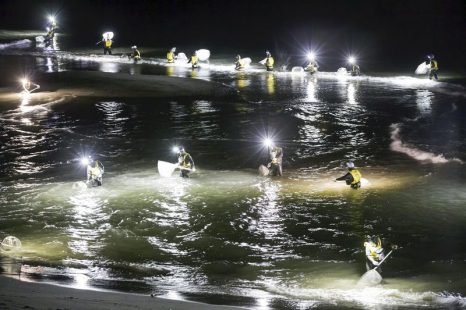
Japanese fishermen, scientists confront eel problem
Off a dark coast near the mouth of the Hishidagawa river in Osaki, Kagoshima Prefecture, countless headlamps glittered and fine-mesh fishing nets fluttered above the cold sea shoals. Fishermen waded through waist-deep water as they carefully looked into their nets, only to lower them once more. Catches of glass eel, or juvenile Japanese eel, have reached critical lows across the nation. In Kagoshima Prefecture, a major eel production area, the total amount of glass eels caught in the 75 days from Dec. 10 — the beginning of this fishing season — was 19.5 percent of that a year earlier. >click to read<11:26
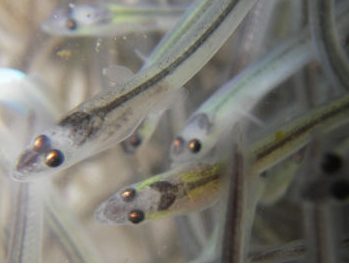
Tiny glass eel draws big money, political muscle and poachers
During the past few years, the GOP-controlled General Assembly has slashed the North Carolina Division of Marine Fisheries budget by about 40 percent, leaving departments understaffed and some employees bending under heavy workloads. At the same time, a review of more than 3,000 public documents shows that several elected and former state Department of Environmental Quality officials prompted what appears to be hundreds of hours of DMF time finding ways to justify obtaining a share of the federal glass eel quota to benefit just one company in Jones County — American Eel Farm, owned by Rick Allyn. click here to read the story 11:26
A look at the global eel trade reveals widespread fraud – In Japan, 9.6 tons of baby eels magically appeared in 2015
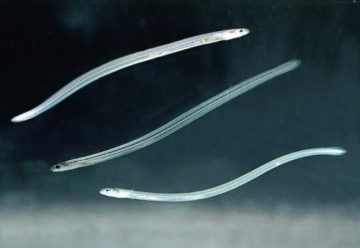 The glass eel trade is coming under international scrutiny. Already, cultured eels account for more than 99% of the world’s supplies. But the farming of these eels is totally reliant on elvers born in the wild. Although techniques to create artificial breeders to allow for the full cultivation of eels have been established, commercial production, as in the case of tuna, remains impossible. A big problem is that much of the glass eel trade essentially takes place in the dark. In Japan, the Fisheries Agency calculates the volume of the country’s eel catches by subtracting the amount of imported baby eels from that of domestic procurement. But the volume of domestic eel catches widely differs from the combined calculations of domestic catches done by prefectural governments, which issue the necessary permits. In the fishing season of 2015, for example, 18.3 tons of baby eels were procured domestically, while 3 tons were imported. The volume of eel caught domestically thus came to 15.3 tons. But data from prefectural governments, once tabulated, puts the total amount of domestic catches at 5.7 tons. The difference suggests that eel farms received 9.6 tons of glass eels from shadowy sources. Read the story here 10:36
The glass eel trade is coming under international scrutiny. Already, cultured eels account for more than 99% of the world’s supplies. But the farming of these eels is totally reliant on elvers born in the wild. Although techniques to create artificial breeders to allow for the full cultivation of eels have been established, commercial production, as in the case of tuna, remains impossible. A big problem is that much of the glass eel trade essentially takes place in the dark. In Japan, the Fisheries Agency calculates the volume of the country’s eel catches by subtracting the amount of imported baby eels from that of domestic procurement. But the volume of domestic eel catches widely differs from the combined calculations of domestic catches done by prefectural governments, which issue the necessary permits. In the fishing season of 2015, for example, 18.3 tons of baby eels were procured domestically, while 3 tons were imported. The volume of eel caught domestically thus came to 15.3 tons. But data from prefectural governments, once tabulated, puts the total amount of domestic catches at 5.7 tons. The difference suggests that eel farms received 9.6 tons of glass eels from shadowy sources. Read the story here 10:36





































